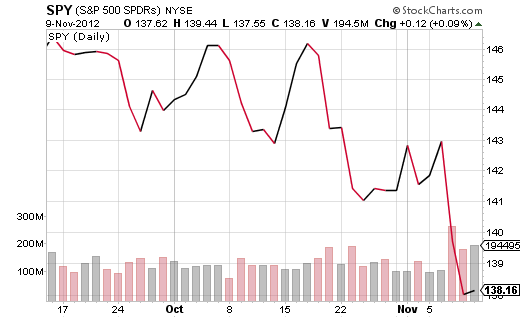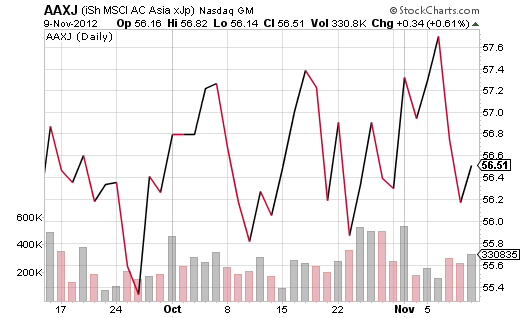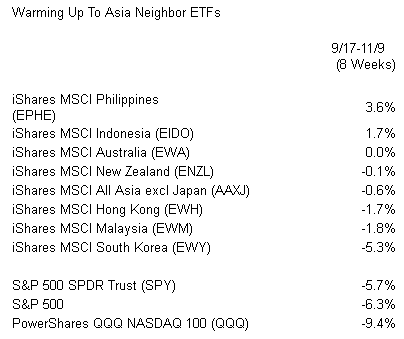Nearly two months ago, Ben Bernanke announced an open-ended promise for the Federal Reserve to purchase $40 billion in mortgage-backed bonds every month. Prior to the 9/13 announcement, investors expected another round of electronic money printing, yet the size and scope of the plan exceeded everyone’s expectations. U.S. stocks surged to multi-year highs through the Friday 9/14 close.
Shortly thereafter, however, U.S. stock assets began to weaken. Not only were corporate revenue reports decidedly weak in October, but many chose to exit riskier assets prior to the presidential election and the subsequent “fiscal cliff” debate.
Realistic fears that the same cast of characters may stumble in their efforts to reach an agreement has seen many investors selling first and asking questions later. The S&P 500 has already forfeited -6.3% over the last 8 weeks.
That said, not every stock ETF has lost ground since 9/14. Asian ETFs have actually held steady.

Keep in mind, China’s inflation has slowed, its manufacturing has picked up, and its leaders have plenty of conventional fiscal and monetary policy tools at their disposal. In other words, the circumstances are enormously beneficial to regional players that support the world’s 2nd largest economy.
Not sure that the worst is over in Asia? Take a look at the recent returns throughout the Asia-Pacific region:
In commentary from previous months, I talked about changes in the economic landscape as well as the relative strength that Asian Neighbor ETFs were demonstrating. For example, in an article from the 1st of October, “Asia Pacific ETFs Become Relative Strength Standouts,” I chronicled the progress of the region’s ETFs over a 10-week period from mid-July. Funds like iShares New Zealand (ENZL) had already moved from a relative strength factor score in the 50th percentile to the 90th percentile.
Obviously, if U.S. political leaders fail miserably on minimizing the extent of simultaneous tax hikes and spending cuts, one shouldn’t expect Asian ETFs to escape unharmed. On the other hand, if you’ve ignored emerging markets for years due to uncertainty about a hard economic landing in China, it’s time to take another look.
Based on a wide variety of ETF selection criteria, I maintain a healthy allocation to iShares All Asia excl Japan (AAXJ) as well as an individual country “fave,” iShares MSCI Malaysia (EWM). The 3.6% annualized dividend yield is 2x the 10-year U.S. treasury. Meanwhile, the country maintains full employment, manageable inflation and steady GDP expansion.
Disclosure: Gary Gordon, MS, CFP is the president of Pacific Park Financial, Inc., a Registered Investment Adviser with the SEC. Gary Gordon, Pacific Park Financial, Inc, and/or its clients may hold positions in the ETFs, mutual funds, and/or any investment asset mentioned above. The commentary does not constitute individualized investment advice. The opinions offered herein are not personalized recommendations to buy, sell or hold securities. At times, issuers of exchange-traded products compensate Pacific Park Financial, Inc. or its subsidiaries for advertising at the ETF Expert web site. ETF Expert content is created independently of any advertising relationships.
- English (UK)
- English (India)
- English (Canada)
- English (Australia)
- English (South Africa)
- English (Philippines)
- English (Nigeria)
- Deutsch
- Español (España)
- Español (México)
- Français
- Italiano
- Nederlands
- Português (Portugal)
- Polski
- Português (Brasil)
- Русский
- Türkçe
- العربية
- Ελληνικά
- Svenska
- Suomi
- עברית
- 日本語
- 한국어
- 简体中文
- 繁體中文
- Bahasa Indonesia
- Bahasa Melayu
- ไทย
- Tiếng Việt
- हिंदी
Asia ETFs Lead The Way After 2-Year Hiatus
Published 11/11/2012, 06:13 AM
Updated 07/09/2023, 06:31 AM
Asia ETFs Lead The Way After 2-Year Hiatus
Latest comments
Loading next article…
Install Our App
Risk Disclosure: Trading in financial instruments and/or cryptocurrencies involves high risks including the risk of losing some, or all, of your investment amount, and may not be suitable for all investors. Prices of cryptocurrencies are extremely volatile and may be affected by external factors such as financial, regulatory or political events. Trading on margin increases the financial risks.
Before deciding to trade in financial instrument or cryptocurrencies you should be fully informed of the risks and costs associated with trading the financial markets, carefully consider your investment objectives, level of experience, and risk appetite, and seek professional advice where needed.
Fusion Media would like to remind you that the data contained in this website is not necessarily real-time nor accurate. The data and prices on the website are not necessarily provided by any market or exchange, but may be provided by market makers, and so prices may not be accurate and may differ from the actual price at any given market, meaning prices are indicative and not appropriate for trading purposes. Fusion Media and any provider of the data contained in this website will not accept liability for any loss or damage as a result of your trading, or your reliance on the information contained within this website.
It is prohibited to use, store, reproduce, display, modify, transmit or distribute the data contained in this website without the explicit prior written permission of Fusion Media and/or the data provider. All intellectual property rights are reserved by the providers and/or the exchange providing the data contained in this website.
Fusion Media may be compensated by the advertisers that appear on the website, based on your interaction with the advertisements or advertisers.
Before deciding to trade in financial instrument or cryptocurrencies you should be fully informed of the risks and costs associated with trading the financial markets, carefully consider your investment objectives, level of experience, and risk appetite, and seek professional advice where needed.
Fusion Media would like to remind you that the data contained in this website is not necessarily real-time nor accurate. The data and prices on the website are not necessarily provided by any market or exchange, but may be provided by market makers, and so prices may not be accurate and may differ from the actual price at any given market, meaning prices are indicative and not appropriate for trading purposes. Fusion Media and any provider of the data contained in this website will not accept liability for any loss or damage as a result of your trading, or your reliance on the information contained within this website.
It is prohibited to use, store, reproduce, display, modify, transmit or distribute the data contained in this website without the explicit prior written permission of Fusion Media and/or the data provider. All intellectual property rights are reserved by the providers and/or the exchange providing the data contained in this website.
Fusion Media may be compensated by the advertisers that appear on the website, based on your interaction with the advertisements or advertisers.
© 2007-2025 - Fusion Media Limited. All Rights Reserved.
